The Carbon Impact of International Tourists to an Island Country
Abstract
:1. Introduction
2. Methodology
2.1. Tourism in Taiwan and Interview Questionnaire
2.2. Estimation of Carbon Emission per Person
3. Results and Discussion
3.1. Total Carbon Emission with and without Considering International Transportation
3.2. Transportation Carbon Emission of International Visitors
3.3. Accommodation Carbon Emission of an International Visitor
3.4. Tourist Activity Carbon Emission of an International Visitor
3.5. Carbon Emission Patterns for Different Visiting Periods and Purposes
3.6. Carbon Emission Patterns for Visitors’ Departure Points, and Annual Carbon Emission of International Visitors
4. Conclusions
Author Contributions
Acknowledgments
Conflicts of Interest
References
- Gössling, S.; Peeters, P. Assessing tourism’s global environmental impact 1900–2050. J. Sustain. Tour. 2015, 23, 639–659. [Google Scholar] [CrossRef]
- Buckley, R. Sustainable tourism: Research and reality. Ann. Tour. Res. 2012, 39, 528–546. [Google Scholar] [CrossRef]
- Sharpley, R. Tourism Development and the Environment: Beyond Sustainability? Earthscan: London, UK, 2009. [Google Scholar]
- Scott, D.; Peeters, P.; Gössling, S. Can tourism deliver its “aspirational” greenhouse gas emission reduction targets? J. Sustain. Tour. 2010, 18, 393–408. [Google Scholar] [CrossRef]
- Gössling, S. Global environmental consequences of tourism. Glob. Environ. Chang. 2002, 12, 283–302. [Google Scholar] [CrossRef]
- Roibás, L.; Loiseau, E.; Hospido, A. Determination of the carbon footprint of all Galician production and consumption activities: Lessons learnt and guidelines for policymakers. J. Environ. Manag. 2017, 198 Pt 1, 289–299. [Google Scholar] [CrossRef] [PubMed]
- Lin, T.-P. Carbon dioxide emissions from transport in Taiwan’s national parks. Tour. Manag. 2010, 31, 285–290. [Google Scholar] [CrossRef]
- Becken, S.; Simmons, D.G.; Frampton, C. Energy use associated with different travel choices. Tour. Manag. 2003, 24, 267–277. [Google Scholar] [CrossRef]
- Tsai, K.-T.; Lin, T.-P.; Hwang, R.-L.; Huang, Y.-J. Carbon dioxide emissions generated by energy consumption of hotels and homestay facilities in Taiwan. Tour. Manag. 2014, 42, 13–21. [Google Scholar] [CrossRef]
- Huang, Z.; Cao, F.; Jin, C.; Yu, Z.; Huang, R. Carbon emission flow from self-driving tours and its spatial relationship with scenic spots—A traffic-related big data method. J. Clean. Prod. 2017, 142, 946–955. [Google Scholar] [CrossRef]
- Peeters, P.; Dubois, G. Tourism travel under climate change mitigation constraints. J. Transp. Geogr. 2010, 18, 447–457. [Google Scholar] [CrossRef]
- Gössling, S. Carbon neutral destinations: A conceptual analysis. J. Sustain. Tour. 2009, 17, 17–37. [Google Scholar] [CrossRef]
- De Vita, G.; Katircioglu, S.; Altinay, L.; Fethi, S.; Mercan, M. Revisiting the environmental Kuznets curve hypothesis in a tourism development context. Environ. Sci. Pollut. Res. 2015, 22, 16652–16663. [Google Scholar] [CrossRef] [PubMed]
- Ozturk, I.; Al-Mulali, U.; Saboori, B. Investigating the environmental Kuznets curve hypothesis: The role of tourism and ecological footprint. Environ. Sci. Pollut. Res. 2016, 23, 1916–1928. [Google Scholar] [CrossRef] [PubMed]
- López-Menéndez, A.J.; Pérez, R.; Moreno, B. Environmental costs and renewable energy: Re-visiting the Environmental Kuznets Curve. J. Environ. Manag. 2014, 145 (Suppl. C), 368–373. [Google Scholar] [CrossRef] [PubMed]
- Becken, S.; Patterson, M. Measuring national carbon dioxide emissions from tourism as a key step towards achieving sustainable tourism. J. Sustain. Tour. 2006, 14, 323–338. [Google Scholar] [CrossRef]
- Oluseyi, P.; Babatunde, O.; Babatunde, O. Assessment of energy consumption and carbon footprint from the hotel sector within Lagos, Nigeria. Energy Build. 2016, 118, 106–113. [Google Scholar] [CrossRef]
- Filimonau, V.; Dickinson, J.; Robbins, D. The carbon impact of short-haul tourism: A case study of UK travel to Southern France using life cycle analysis. J. Clean. Prod. 2014, 64, 628–638. [Google Scholar] [CrossRef]
- Loo, B.P.Y.; Li, L. Carbon dioxide emissions from passenger transport in China since 1949: Implications for developing sustainable transport. Energy Policy 2012, 50, 464–476. [Google Scholar] [CrossRef]
- Tang, C.; Zhong, L.; Fan, W.; Cheng, S. Energy consumption and carbon emission for tourism transport in World Heritage Sites: A case of the Wulingyuan area in China. Nat. Resour. Forum 2015, 39, 134–150. [Google Scholar] [CrossRef]
- Hoxter, A.L.; Lester, D. Tourist behavior and personality. Personal. Individ. Differ. 1988, 9, 177–178. [Google Scholar] [CrossRef]
- Ortega, E.; Rodríguez, B. Information at tourism destinations. Importance and cross-cultural differences between international and domestic tourists. J. Bus. Res. 2007, 60, 146–152. [Google Scholar] [CrossRef]
- Jones, T.E.; Yamamoto, K. Segment-based monitoring of domestic and international climbers at Mount Fuji: Targeted risk reduction strategies for existing and emerging visitor segments. J. Outdoor Recreat. Tour. 2016, 13, 10–17. [Google Scholar] [CrossRef]
- Rutty, M.; Scott, D. Comparison of climate preferences for domestic and international beach holidays: A case study of Canadian travelers. Atmosphere 2016, 7, 30. [Google Scholar] [CrossRef]
- Kozak, M. Comparative analysis of tourist motivations by nationality and destinations. Tour. Manag. 2002, 23, 221–232. [Google Scholar] [CrossRef]
- Carr, N. A comparative analysis of the behaviour of domestic and international young tourists. Tour. Manag. 2002, 23, 321–325. [Google Scholar] [CrossRef]
- Yang, M.-D.; Chen, Y.-P.; Lin, Y.-H.; Ho, Y.-F.; Lin, J.-Y. Multiobjective optimization using nondominated sorting genetic algorithm-II for allocation of energy conservation and renewable energy facilities in a campus. Energy Build. 2016, 122, 120–130. [Google Scholar] [CrossRef]
- UNEp, O.; IEA, I. Revised IPCC Guidelines for National Greenhouse Gas Inventories; IPCC: Bracknell, UK, 1996. [Google Scholar]
- Collier, A. Principles of Tourism; Pitman Publishing: London, UK, 1989. [Google Scholar]
- Becken, S. Energy Consumption of Tourist Attractions and Activities in New Zealand: Summary Report of a Survey; Lincoln University: Lincoln, UK, 2001. [Google Scholar]
- Chiu, Y.-T. Carbon Emissions and Ecological Footprint of Foreign Tourists in Taiwan; National Formosa University: Yunlin, Taiwan, 2012. [Google Scholar]
- Sun, Y.-Y. A framework to account for the tourism carbon footprint at island destinations. Tour. Manag. 2014, 45, 16–27. [Google Scholar] [CrossRef]
- Tang, Z.; Shang, J.; Shi, C.; Liu, Z.; Bi, K. Decoupling indicators of CO2 emissions from the tourism industry in China: 1990–2012. Ecol. Indic. 2014, 46, 390–397. [Google Scholar] [CrossRef]
- Robaina-Alves, M.; Moutinho, V.; Costa, R. Change in energy-related CO2 (carbon dioxide) emissions in Portuguese tourism: A decomposition analysis from 2000 to 2008. J. Clean. Prod. 2016, 111, 520–528. [Google Scholar] [CrossRef]
- Lew, A.; McKercher, B. Modeling Tourist Movements: A Local Destination Analysis. Ann. Tour. Res. 2006, 33, 403–423. [Google Scholar] [CrossRef]
- Kelly, J.; Haider, W.; Williams, P.W. A behavioral assessment of tourism transportation options for reducing energy consumption and greenhouse gases. J. Travel Res. 2007, 45, 297–309. [Google Scholar] [CrossRef]
- Le-Klähn, D.-T.; Hall, C.M. Tourist use of public transport at destinations—A review. Curr. Issues Tour. 2015, 18, 785–803. [Google Scholar] [CrossRef]
- Sun, Y.-Y.; Pratt, S. The economic, carbon emission, and water impacts of Chinese visitors to Taiwan: Eco-efficiency and impact evaluation. J. Travel Res. 2014, 53, 733–746. [Google Scholar] [CrossRef]
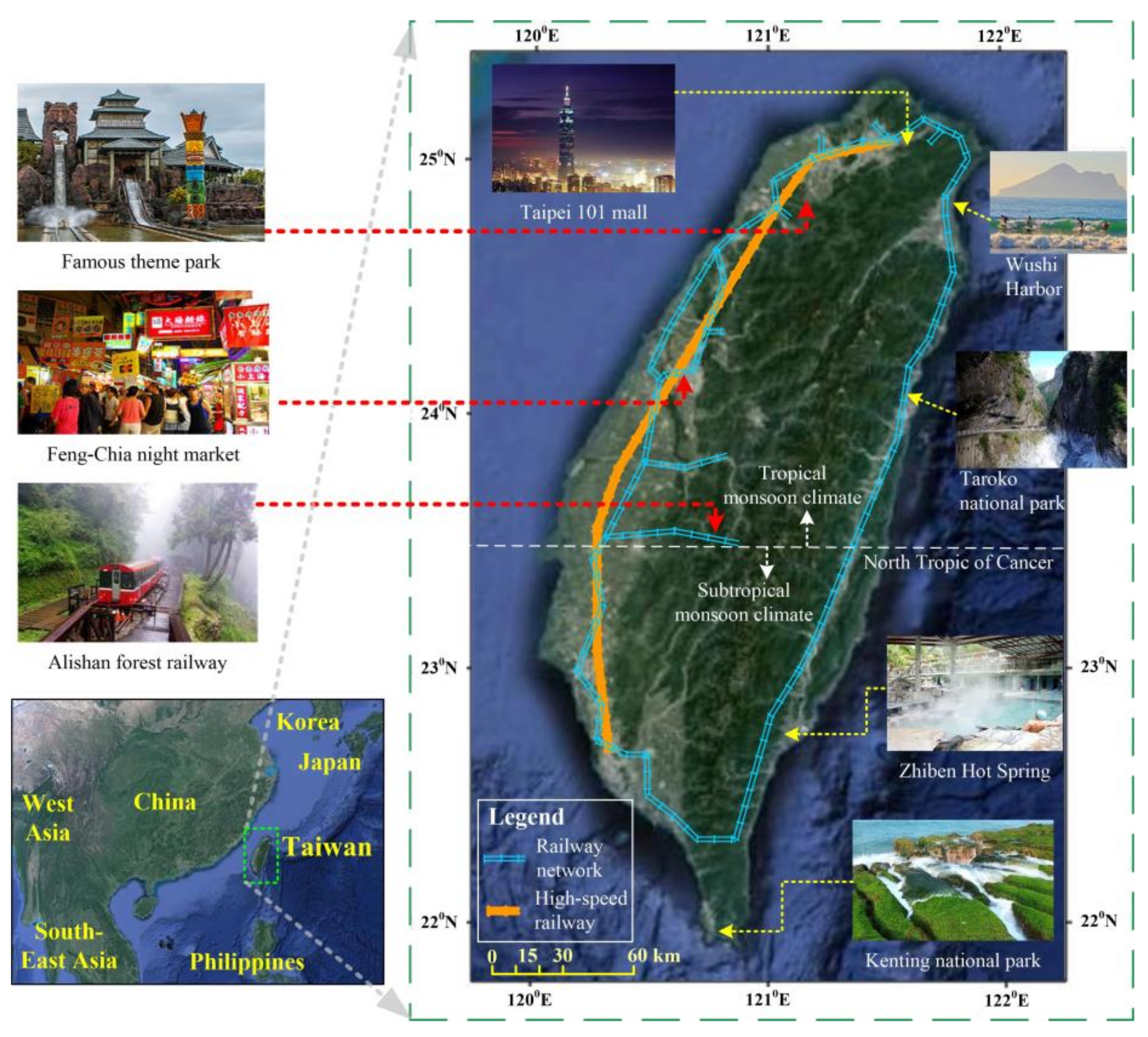
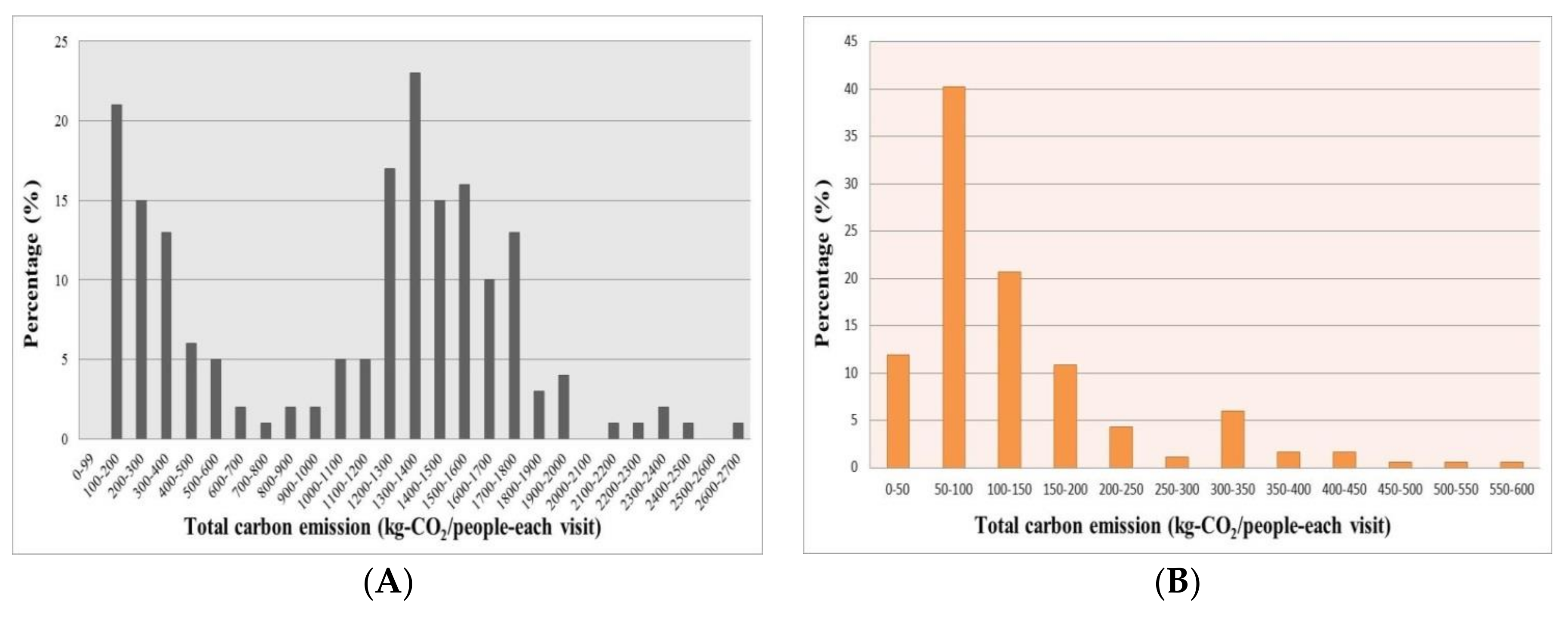
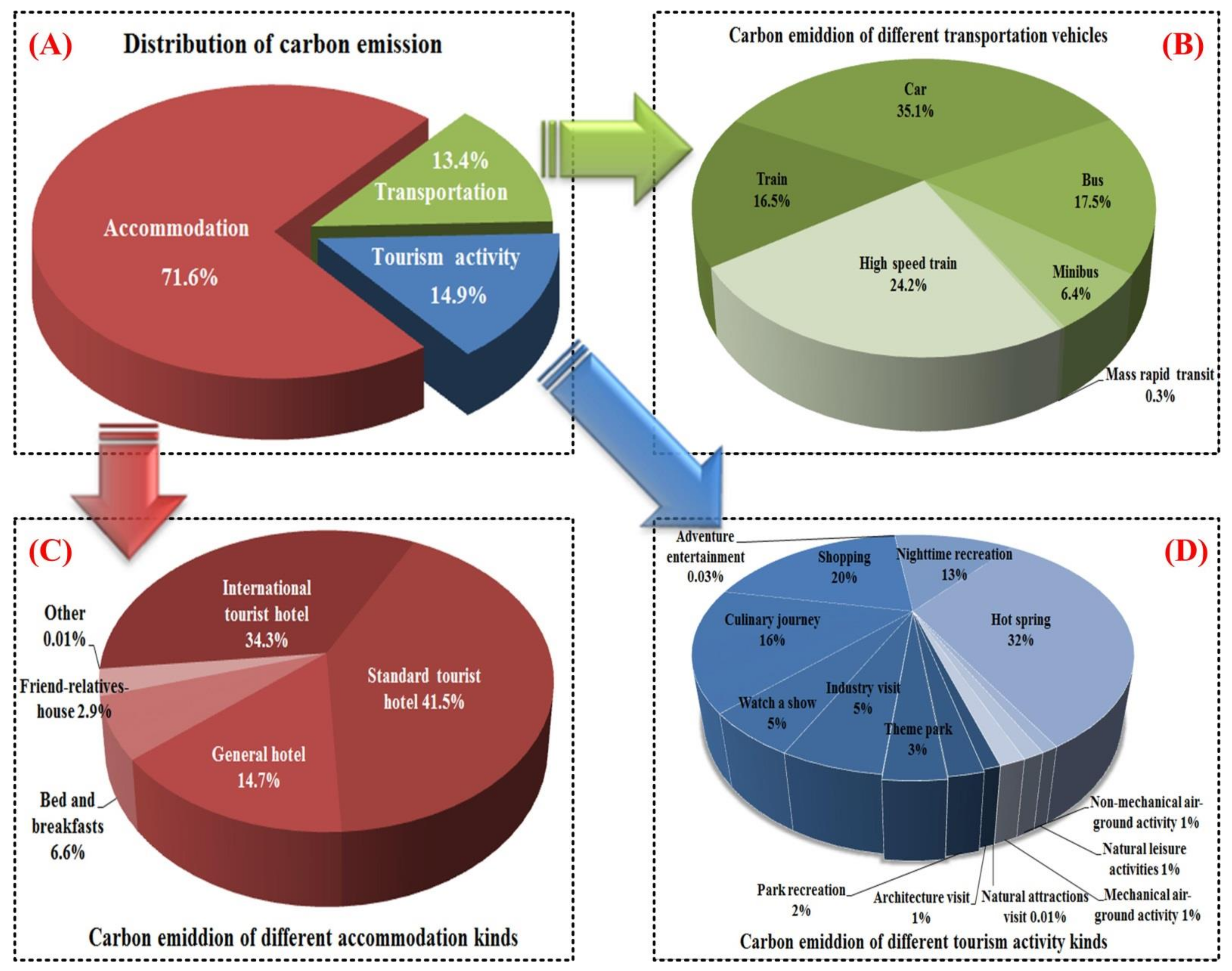
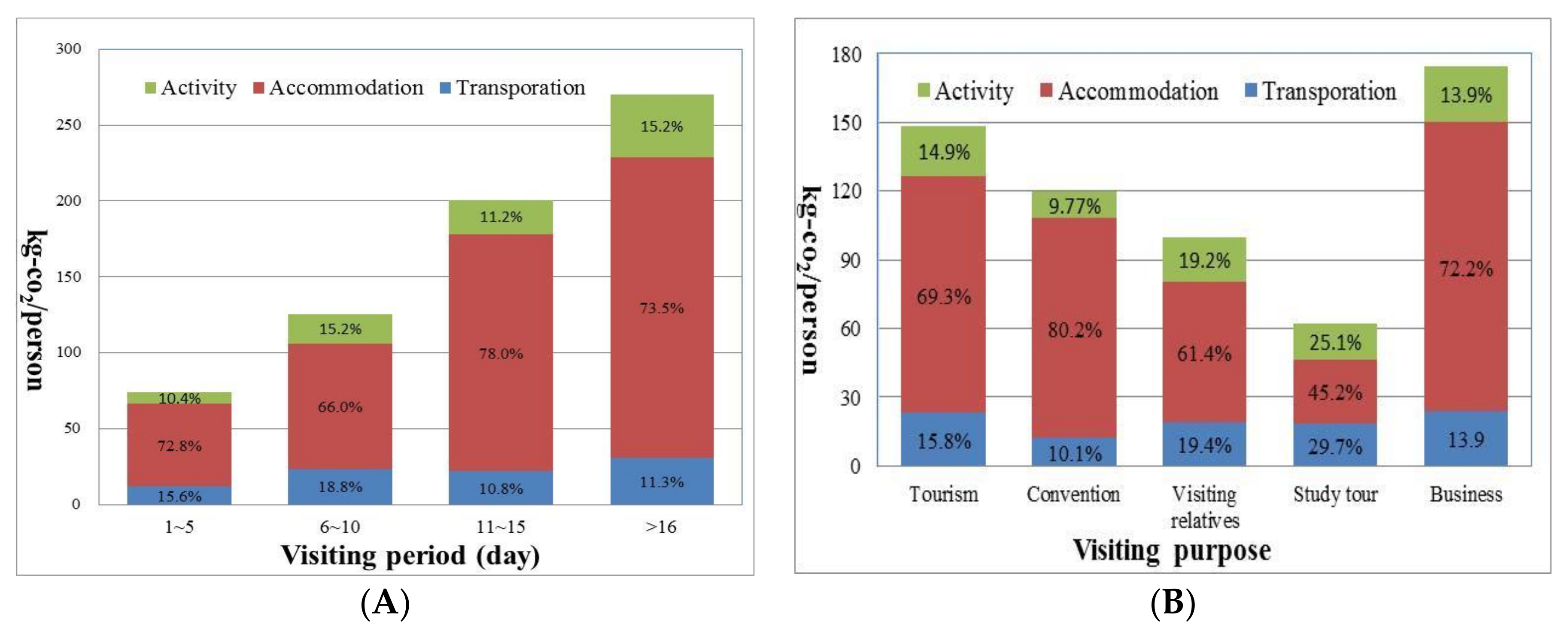
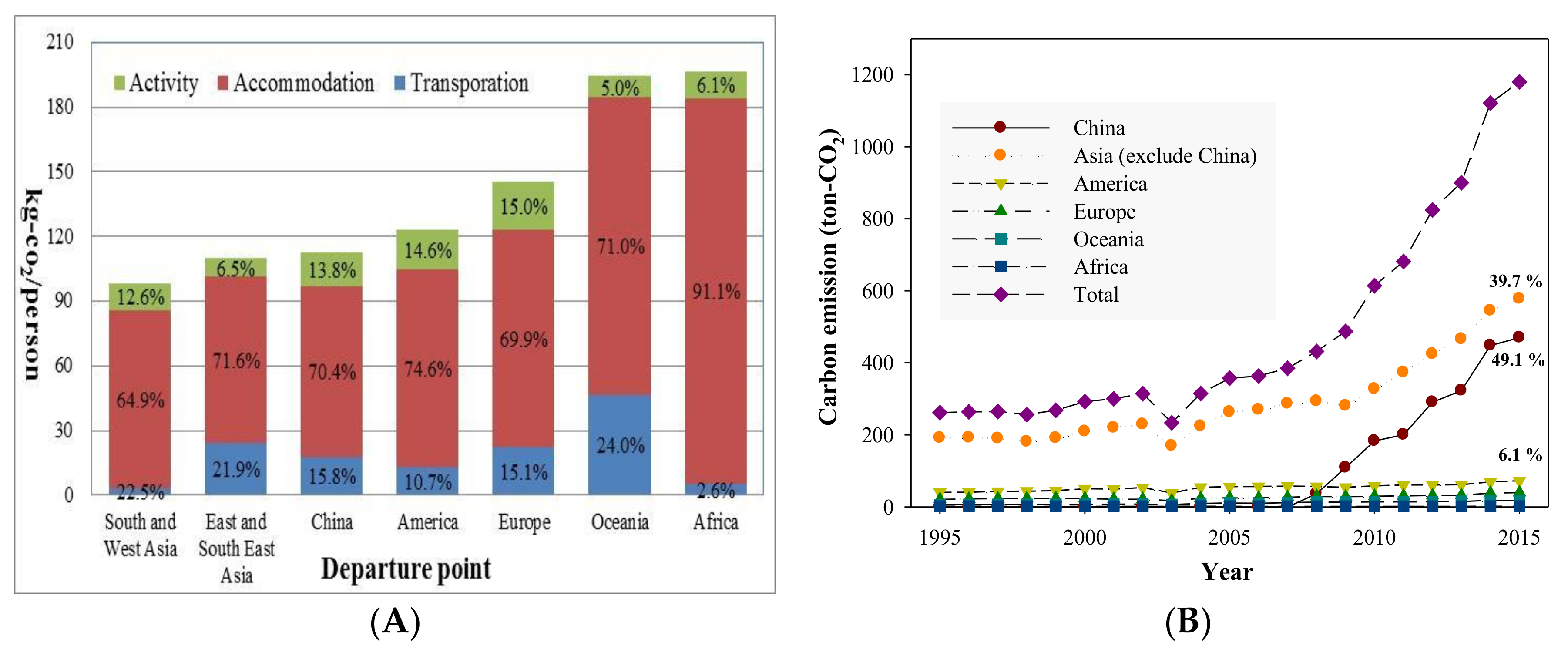
| Transportation Mode | Selected Probability (%) a | Distance (km/Person) a | Carbon Emission Coefficient (kg CO2/km) b | |
|---|---|---|---|---|
| Average | Deviation | |||
| Car | 29.5 | 173.9 | 214.4 | 0.096 |
| Bus | 22.2 | 404.6 | 320.7 | 0.028 |
| High speed rail | 20.2 | 258.3 | 144.7 | 0.070 |
| Train | 19.4 | 361.3 | 274.2 | 0.034 |
| Minibus | 4.4 | 402.0 | 376.0 | 0.052 |
| Mass rapid transit | 4.4 | 31.9 | 0.0 | 0.034 |
| Total | 100 | - | - | - |
| Accommodation Type | Selected Probability (%/Person-Night) a | Carbon Emission Coefficient (kg CO2/Person-Night) b |
|---|---|---|
| Standard tourist hotel | 31.1 | 19.2 |
| International tourist hotel | 24.6 | 20.15 |
| Friend/relative’s house | 13.1 | 3.00 |
| General hotels | 16.3 | 12.47 |
| Bed-and-breakfast | 14.3 | 6.32 |
| Other (such as tent) | 0.6 | 0.0 |
| Total | 100 | - |
| Activity | Selected Probability (%/Person-Night) a | Carbon Emission Coefficient [Ak (kg CO2/Person)] b | |
|---|---|---|---|
| Kind | Example | ||
| Hot spring | Going to hot springs | 5.0 | 9.99 |
| Theme park | Theme park tour | 1.4 | 3.46 |
| Watch a show | Aboriginal cultural experience | 3.1 | 2.57 |
| Mechanical air-ground activity | Yacht tourism | 0.9 | 2.42 |
| Industry visit | Visit orchard | 4.3 | 1.85 |
| Nighttime recreation | Nightclub | 10.2 | 1.85 |
| Shopping | Shopping | 19.1 | 1.62 |
| Culinary journey | Taste famous food in night markets | 22.5 | 1.10 |
| Nonmechanical air-ground activity | Surf | 2.2 | 0.85 |
| Park recreation | Picnic | 6.0 | 0.47 |
| Natural leisure activities | Cycling | 5.6 | 0.28 |
| Architecture visit | Visit special buildings | 14.1 | 0.1 |
| Adventure entertainment | Climbing mount | 3.3 | 0.02 |
| Natural attractions activity | Geological landscape | 2.3 | 0.007 |
| Total | 100 | ||
© 2018 by the authors. Licensee MDPI, Basel, Switzerland. This article is an open access article distributed under the terms and conditions of the Creative Commons Attribution (CC BY) license (http://creativecommons.org/licenses/by/4.0/).
Share and Cite
Tsai, K.-T.; Lin, T.-P.; Lin, Y.-H.; Tung, C.-H.; Chiu, Y.-T. The Carbon Impact of International Tourists to an Island Country. Sustainability 2018, 10, 1386. https://doi.org/10.3390/su10051386
Tsai K-T, Lin T-P, Lin Y-H, Tung C-H, Chiu Y-T. The Carbon Impact of International Tourists to an Island Country. Sustainability. 2018; 10(5):1386. https://doi.org/10.3390/su10051386
Chicago/Turabian StyleTsai, Kang-Ting, Tzu-Ping Lin, Yu-Hao Lin, Chien-Hung Tung, and Yi-Ting Chiu. 2018. "The Carbon Impact of International Tourists to an Island Country" Sustainability 10, no. 5: 1386. https://doi.org/10.3390/su10051386
APA StyleTsai, K.-T., Lin, T.-P., Lin, Y.-H., Tung, C.-H., & Chiu, Y.-T. (2018). The Carbon Impact of International Tourists to an Island Country. Sustainability, 10(5), 1386. https://doi.org/10.3390/su10051386







